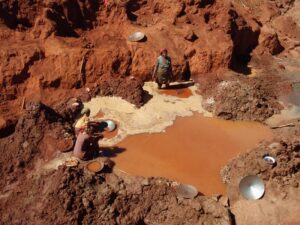Reviewing: Cusset, Fanny, et al. “A century of mercury: Ecosystem-wide changes drive increasing contamination of a tropical seabird species in the South Atlantic Ocean.” Environmental Pollution (2023): 121187. Featured photo from Flickr.
Mercury is a toxic metal that can cause severe physical and neurological damage in living organisms. While some of the mercury in the environment naturally occurs from volcanic eruptions and forest fires, increasing amounts of mercury have been released into the atmosphere by human activities, such as mining, coal burning, and usage of mercury-containing products, since the Industrial Revolution. Once released, mercury remains in the atmosphere for up to a year, traveling long distances around the globe, before it falls onto the ocean or on land. When mercury enters the ocean, microbes in the ocean transform mercury into methylmercury, a form of mercury that is most toxic for living organisms. Methylmercury binds to tissues and accumulates in bodies over time. When organisms higher up on the food web feeds on organisms with methylmercury in their tissues, they will also start accumulating mercury in their bodies. Therefore, tracking mercury contamination in the ocean is very important for both wildlife and human health.


One way to monitor mercury contamination in the ocean is by measuring the amount of mercury in seabird feathers. Seabirds are exposed to mercury mainly by their diet. Up to 90% of the methylmercury they took in from their food moves through their blood and gets incorporated into their feathers. The team of scientists decided to collect feathers from the sooty tern, the most abundant tropical seabird species, from the Ascension Island. The Ascension Island is an isolated island in the middle of the tropical South Atlantic Ocean, and harbors the largest breeding population of sooty terns in the Atlantic Ocean (>200,000 pairs). The scientists not only gathered molted sooty tern feathers from living birds on the Ascension Island, but also collected feathers from multiple natural history museum collections. This allowed them to look at long-term effects of mercury on sooty terns over 145 years (1876-2021).
The scientists found that mercury concentrations in sooty tern feathers were almost 60% higher in the 2020s than in the 1920s. More specifically, they found that mercury concentrations increased between 1920s-1970s and 2000s-present day. They suggest that the increase between 1920s-1970s is likely due to higher mercury emission from increasing human industrial activities, including the Gold Rush and coal burning. Mercury concentrations in sooty tern feathers were relatively stable between 1970s-2000s, but this needs to be taken with a grain of salt, since there were less numbers of feathers available from this time period than others. From 2000s-present, mercury concentrations in feathers increased again, despite multiple new regulations enforced to control and reduce global mercury emission. This result potentially raises concerns for the long-term consequences of mercury on our ecosystems.

The scientists also noticed that the increase in mercury concentrations they observed from sooty tern feathers was smaller than the increases reported from other similar studies in the North Atlantic Ocean. Since anthropogenic mercury mostly comes from industrialized countries in the Northern Hemisphere, oceans closer to the continents in the Northern Hemisphere (like the North Atlantic Ocean) would be polluted with mercury much faster than oceans further from the continents (like the tropical South Atlantic Ocean, where feathers for this study were collected). The difference between the degree of mercury contamination in seabird feathers in different areas of the ocean shows the time lag between mercury emission to the atmosphere, deposition in the ocean, and contamination of wildlife. Studies like these really highlight the importance of monitoring mercury pollution over long periods of time, so that we can continue to assess how healthy the marine ecosystems are over time, and can better understand the risks of mercury exposure to wildlife and humans.
I am a PhD student in chemical oceanography at University of Washington. I am studying how different forms of metals in the ocean are shaping microbial communities in the North Pacific Ocean. When not working, I like going for a walk, visiting farmers’ markets and playing keyboard.

